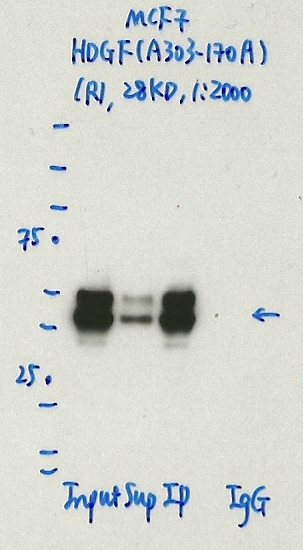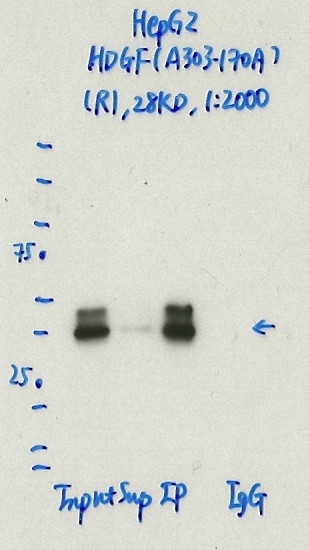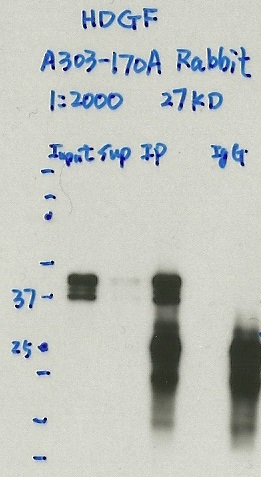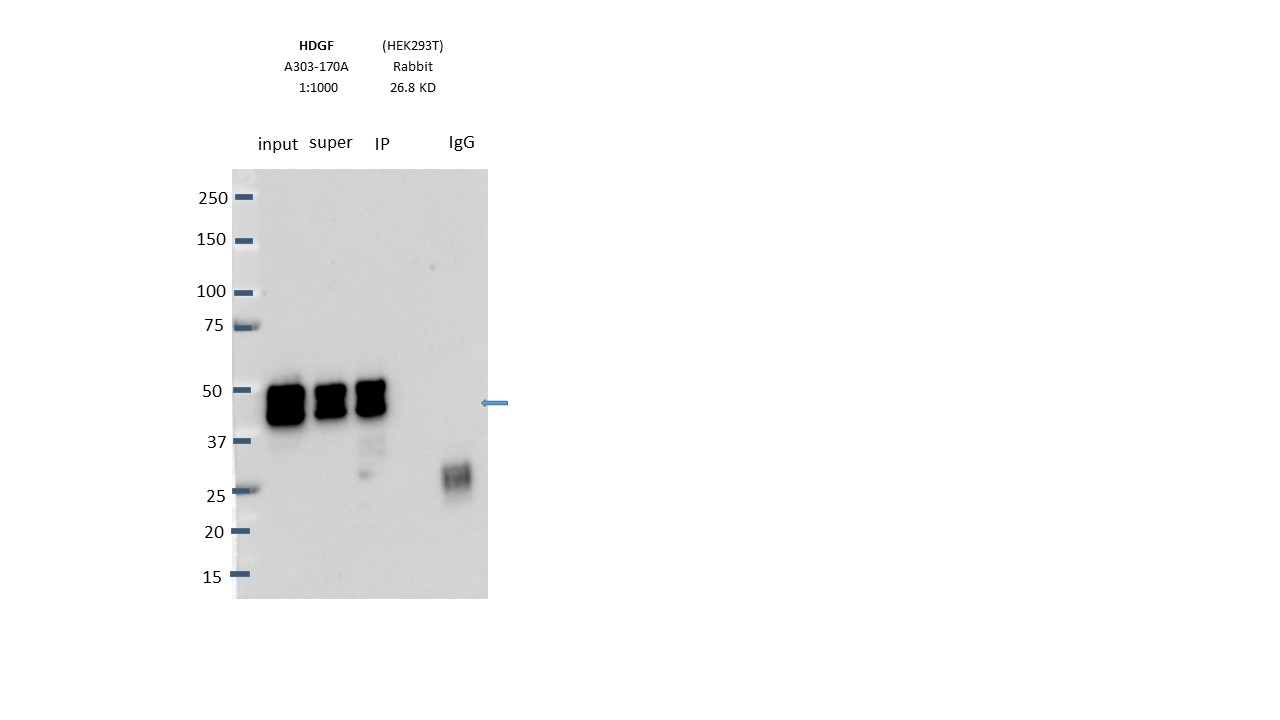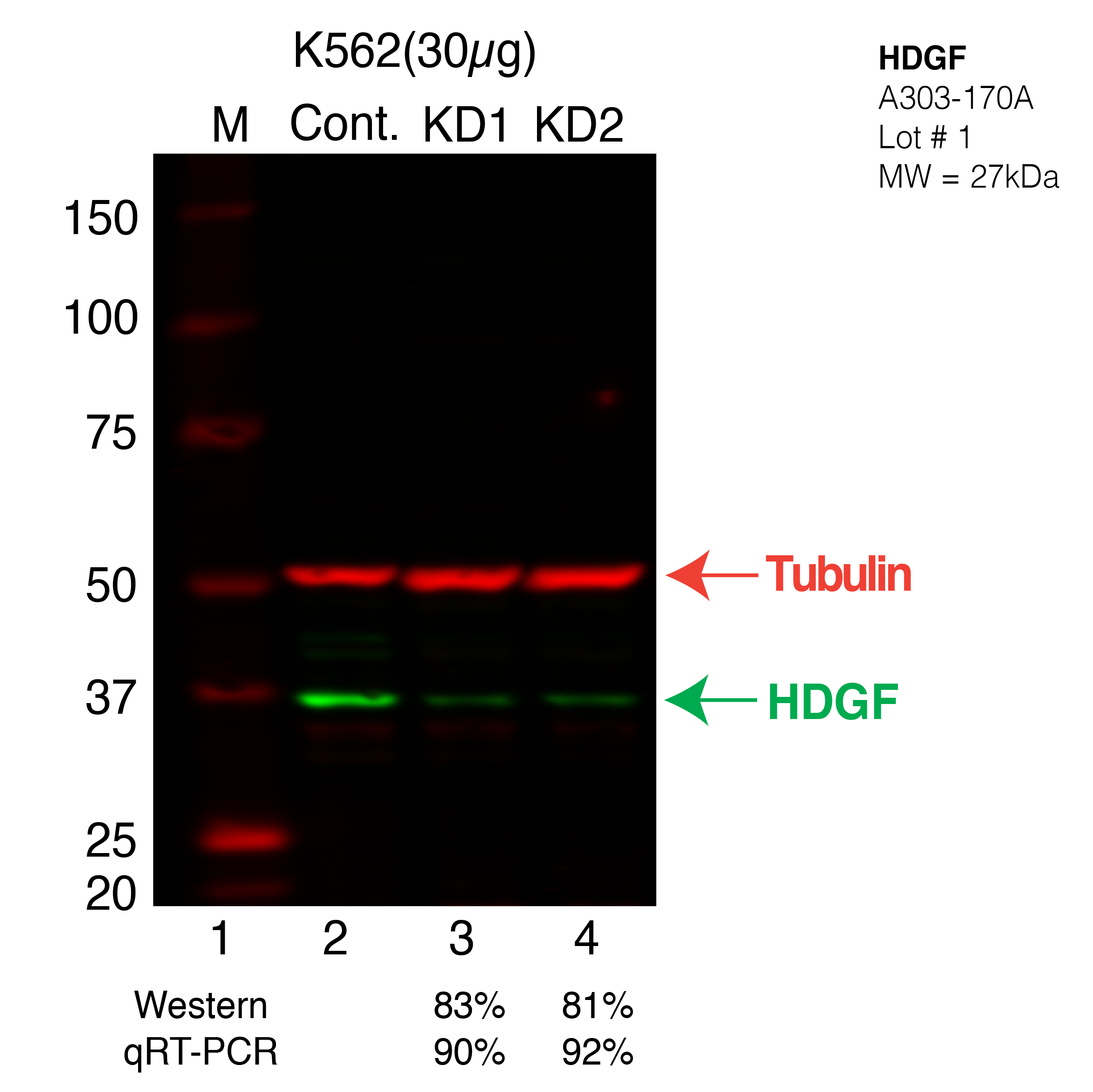ENCAB173GGB
Antibody against Homo sapiens HDGF
Homo sapiens
MCF-7, HepG2
characterized to standards
Homo sapiens
K562, GM12878, HEK293T
characterized to standards with exemption
Homo sapiens
any cell type or tissue
partially characterized
- Status
- released
- Source (vendor)
- Bethyl Labs
- Product ID
- A303-170A
- Lot ID
- 1
- Characterized targets
- HDGF (Homo sapiens)
- Host
- rabbit
- Clonality
- polyclonal
- Purification
- affinity
- Isotype
- IgG
- External resources
Characterizations
HDGF (Homo sapiens)
MCF-7
compliant
- Caption
- Immunoprecipitation was performed on nuclear extracts from the cell line: MCF-7, using the antibody A303-170A. The blot shows western blot analysis of input, flowthrough, immunoprecipitate and mock immunoprecipitate using IgG. Molecular weight: 26788 Da
- Submitted by
- Denis Salins
- Lab
- Michael Snyder, Stanford
- Grant
- U54HG006996
- Download
- 1058_7_HDGF_A303-170A.jpg
HDGF (Homo sapiens)
HepG2
compliant
- Caption
- Immunoprecipitation was performed on nuclear extracts from the cell line: HepG2, using the antibody A303-170A. The blot shows western blot analysis of input, flowthrough, immunoprecipitate and mock immunoprecipitate using IgG. Expected Molecular Weight: 28 KD
- Submitted by
- Denis Salins
- Lab
- Michael Snyder, Stanford
- Grant
- U54HG006996
- Download
- 1058_8_HDGF_A303-170A.jpg
HDGF (Homo sapiens)
K562
exempt from standards
- Caption
- Immunoprecipitation was performed on nuclear extracts from the cell line: K562, using the antibody A303-170A. The blot shows western blot analysis of input, flowthrough, immunoprecipitate and mock immunoprecipitate using IgG.
- Submitter comment
- HDGF is known to form a domain-swapped homodimer that can be stable even in reducing gels (PMID: 17270212)
- Reviewer comment
- Higher than expected size and multiple bands were noted. In response to the submitter's comment, the stable domain-swapped homodimer would explain the higher (double-sized) band and also explain why the ratio of the two bands can be different on different westerns.
- Submitted by
- Denis Salins
- Lab
- Michael Snyder, Stanford
- Grant
- U54HG006996
- Download
- 6.jpg
HDGF (Homo sapiens)
not submitted for review by lab
- Caption
- IP-WB analysis of K562 whole cell lysate using HDGF specific antibody. Lane 1 is 2.5% of 0.5mg input lysate, lane 2 is 2.5% of supernatant after immunoprecipitation and Lane 3 is 50% of IP enrichment using rabbit polyclonal HDGF Antibody. This antibody passes preliminary validation and will be further pursued for primary and secondary validation.
- Submitted by
- Balaji Sundararaman
- Lab
- Gene Yeo, UCSD
- Grant
- U54HG007005
- Download
- Bethyl_A303-170A_1_HDGF.png
HDGF (Homo sapiens)
GM12878
exempt from standards
- Caption
- Immunoprecipitation was performed on nuclear extracts from the cell line: GM12878, using the antibody A303-170A. The image shows western blot analysis of input, flowthrough, immunoprecipitate, and mock immunoprecipitate using IgG. Target molecular weight: 26.788.
- Submitter comment
- HDGF is known to form a domain-swapped homodimer that can be stable even in reducing gels (PMID: 17270212)
- Reviewer comment
- Higher than expected size and multiple bands were noted. In response to the submitter's comment, the stable domain-swapped homodimer would explain the higher (double-sized) band and also explain why the ratio of the two bands can be different on different westerns.
- Submitted by
- Nathaniel Watson
- Lab
- Michael Snyder, Stanford
- Grant
- U54HG006996
- Download
- expt1061_3-HDGF-A303-170A-1.jpg
HDGF (Homo sapiens)
HEK293T
exempt from standards
- Caption
- Immunoprecipitation was performed on nuclear extracts from the cell line: HEK293T, using the antibody A303-170A. The image shows western blot analysis of input, flowthrough, immunoprecipitate, and mock immunoprecipitate using IgG. Target molecular weight: 26.788.
- Submitter comment
- HDGF is known to form a domain-swapped homodimer that can be stable even in reducing gels (PMID: 17270212)
- Reviewer comment
- Higher than expected size and multiple bands were noted. In response to the submitter's comment, the stable domain-swapped homodimer would explain the higher (double-sized) band and also explain why the ratio of the two bands can be different on different westerns.
- Submitted by
- Nathaniel Watson
- Lab
- Michael Snyder, Stanford
- Grant
- U54HG006996
- Download
- Expt1115_3-HDGF-A303-170A-1.jpg
HDGF (Homo sapiens)
compliant
- Caption
- Western blot following shRNA against HDGF in HepG2 whole cell lysate using HDGF specific antibody. Lane 1 is a ladder, lane 2 is HepG2 non-targeting control knockdown, lane 3 and 4 are two different shRNAs against HDGF.HDGF protein appears as the green band, Tubulin serves as a control and appears in red.
- Submitted by
- Xintao Wei
- Lab
- Brenton Graveley, UConn
- Grant
- U54HG007005
- Download
- HDGF-HEPG2_Secondary_Western.png
HDGF (Homo sapiens)
compliant
- Caption
- Western blot following shRNA against HDGF in K562 whole cell lysate using HDGF specific antibody. Lane 1 is a ladder, lane 2 is K562 non-targeting control knockdown, lane 3 and 4 are two different shRNA against HDGF.HDGF protein appears as the green band, Tubulin serves as a control and appears in red.
- Submitted by
- Xintao Wei
- Lab
- Brenton Graveley, UConn
- Grant
- U54HG007005
- Download
- HDGF-K562.png
